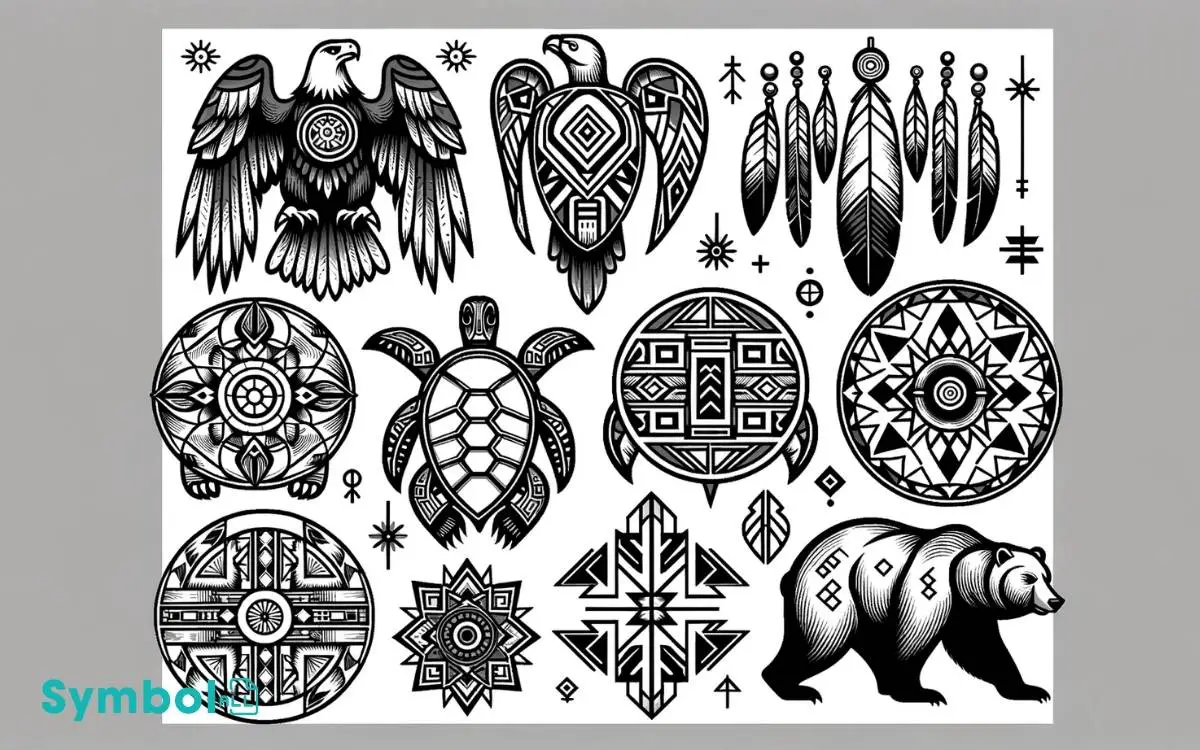Native American Symbols Coloring Pages: Explains!
Coloring Native American symbols like the powerful Thunderbird, protective Dreamcatchers, story-rich Totem Poles, joyful Kokopelli, and the insightful Medicine Wheel offers you a heartfelt way to connect with Indigenous cultures.
You’ll embrace centuries of respect for nature, narratives, and spirituality through each stroke. These symbols, embodying power, protection, fertility, and understanding of the universe, bring you closer to the essence of traditions passed down through generations.
Coloring them isn’t just an activity; it’s a journey of appreciation and learning. Let each page unfold more about this vibrant cultural heritage, enriching your understanding.

Key Takeaways
10 Native American Symbols Coloring Pages
| Symbol | Description | Coloring Page Difficulty | Ideal Age Range |
|---|---|---|---|
| Dreamcatcher | A hand-woven object designed to protect the sleeper from bad dreams. | Medium | 6-12 years |
| Thunderbird | A legendary creature in certain North American indigenous peoples’ history. | Hard | 8+ years |
| Totem Pole | A monument created by the Pacific Northwest tribes to represent family. | Hard | 7+ years |
| Turtle | Represents Mother Earth and is a symbol for good health and long life. | Easy | 4-8 years |
| Bear | A symbol of strength, courage, and leadership. | Medium | 6-12 years |
| Eagle | A sacred bird that symbolizes honesty, truth, majesty, and power. | Hard | 8+ years |
| Kokopelli | A fertility deity, usually depicted as a humpbacked flute player. | Medium | 6-12 years |
| Feather | Represents trust, honor, strength, wisdom, power, and freedom. | Easy | 4-8 years |
| Arrowhead | Symbolizes alertness and direction. | Easy | 5-9 years |
| Medicine Wheel | Represents the circle of life and the four directions. | Medium | 6-12 years |
Exploring the Thunderbird Symbol
The Thunderbird symbol, deeply respected in Native American culture, represents power, protection, and strength.
As you explore the world of Native American symbols through coloring pages, you’re not just filling spaces with color; you’re connecting with centuries-old beliefs and traditions.
The Thunderbird, often portrayed with wide-spread wings and a powerful gaze, isn’t just an artistic element. It’s a bridge to understanding the profound respect Indigenous peoples have for the natural world and its forces.
By coloring this symbol, you’re paying homage to a creature believed to control the elements, a guardian of the skies who commands thunder and lightning.
Through your creative expression, you engage with a symbol that has guided, protected, and inspired countless generations, bringing its timeless essence into your own experience.
The Significance of Dreamcatchers
Dreamcatchers, originating from Native American cultures, serve as protectors against nightmares, filtering out bad dreams and allowing only good thoughts to enter your mind as you sleep.
Traditionally crafted with a willow hoop and adorned with items like feathers and beads, they embody a spiritual significance. Hanging a dreamcatcher above your bed is believed to catch dreams as they flow by.
The good dreams, understanding the way through the webbing, gently slide down the feathers to comfort the sleeper below. Meanwhile, the bad dreams, not knowing the way, become entangled in the web and perish with the first light of dawn.
Embracing this symbol in your space connects you with a deeper, spiritual layer of protection and peace.
Totem Poles and Their Stories
Totem poles, towering monuments carved from trees, narrate the rich stories and legends of Native American tribes, embodying their cultural beliefs and heritage.
Each pole is a vibrant tapestry of symbols, where animals and mythical beings represent traits, stories, or historical events significant to the tribe. You’re not just looking at art; you’re witnessing a visual language passed down through generations.
These carvings serve as a bridge to the past, keeping the community’s stories alive. When coloring these symbols, you’re connecting with a profound tradition, embracing an opportunity to learn and share in the preservation of these narratives.
It’s a respectful journey into the heart of cultures that have thrived on this land for thousands of years, inviting you to appreciate their depth and resilience.
The Mystery of Kokopelli
Among the myriad of Native American symbols, Kokopelli holds a place of fascination and enigma, intriguing those who seek to understand its origins and meanings. This humpbacked flute player isn’t just a simple figure; it embodies complexity and depth.
Here’s why you’ll find Kokopelli so mesmerizing:
- Represents fertility: Often linked to agriculture, childbirth, and the spirit of music.
- A trickster: Kokopelli possesses qualities of a trickster god, bringing change and laughter.
- Ancient origins: Traces back to over 3,000 years ago across various Native American cultures.
- Symbol of joy: Known to spread happiness and good fortune.
- Cultural icon: Remains a powerful symbol in modern Native American art and ceremonies.
Dive into the mystery of Kokopelli, and you’ll discover a symbol rich in history and significance.
Understanding the Medicine Wheel
As you explore the medicine wheel, you’ll uncover its origins and the rich symbolic meanings it holds.
This ancient symbol serves as a guide to understanding the universe, the cycles of life, and our place within it.
Let’s take a closer look at how each point on the wheel offers insights into spiritual and physical well-being.
Medicine Wheel Origins
Delving into the origins of the Medicine Wheel reveals its deep roots in various Native American cultures as a symbol of holistic health and the cycle of life.
- Each direction of the wheel offers unique teachings and color associations, reflecting life’s diverse aspects.
- Traditionally, it’s used in healing practices, emphasizing balance and interconnectedness.
- The concept predates written history, passed down through generations via oral traditions.
- Its structure and symbolism vary among different tribes, each adding their layer of meaning.
- Despite these variations, the core message of unity and harmony with the natural world remains constant.
Understanding the Medicine Wheel’s origins helps you appreciate its significance beyond a mere symbol, recognizing it as a profound guide to living harmoniously within the natural and spiritual worlds.
Symbolic Meanings Explained
Building on our understanding of the Medicine Wheel‘s origins, let’s explore its symbolic meanings and how they guide us toward a balanced life.
The Medicine Wheel represents the interconnectedness of all life, embodying principles of harmony and balance. Each direction east, south, west, and north holds unique teachings and attributes.
The east symbolizes new beginnings and wisdom, guiding you to listen to your inner voice. The south encourages emotional growth and understanding, fostering a nurturing attitude toward oneself and others.
The west represents introspection and reflection, inviting you to look within and find your inner strength. Finally, the north emphasizes the importance of sharing knowledge and community, reminding you that wisdom is meant to be passed on.
Through these teachings, the Medicine Wheel offers a path to holistic well-being and spiritual fulfillment.
The Spirit of the Eagle Feather
The spirit of the eagle feather symbolizes courage, strength, and freedom in many Native American cultures. As you color in the intricate designs of the eagle feather on your coloring pages, you’re not just filling in another picture.
You’re connecting with a deep and meaningful symbol that has been revered for generations.
- Courage: Representing the bravery required to face life’s challenges.
- Strength: Symbolizing the inner strength and resilience of the spirit.
- Freedom: Reflecting the ultimate freedom of the soul, transcending the physical sphere.
- Wisdom: Eagles are seen as wise creatures, and their feathers convey this wisdom.
- Connection: Serving as a bridge between the earthly world and the spiritual dimension.
The Legend of the Turtle
Across many Native American cultures, the turtle symbol holds profound significance, embodying the earth’s stability and the cycles of life and time. This revered creature represents endurance, longevity, and the foundation of existence.
You’ll find that in many legends, the turtle carries the world on its back, highlighting its role as an earth-supporter. It’s a messenger of peace and an emblem of perseverance.
As you explore these coloring pages, you’re not just filling in shapes; you’re connecting with ancient wisdom and the sacredness of life.
The turtle teaches you to pace yourself, to find harmony with your surroundings, and to remember that life is a journey that unfolds in its own time. Let each stroke of color remind you of the turtle’s enduring spirit.
Conclusion
As you’ve explored the rich tapestry of Native American symbols through coloring pages, you’ve not just added color to paper but also to your understanding of a vibrant culture.
Ironically, while we aim to capture the essence of these symbols with our crayons and pencils, their true colors and depths can’t be fully contained on paper.
So, as you admire your artwork, remember it’s just a glimpse into a world where every hue tells a story far beyond the page.






